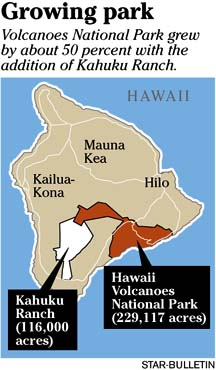
ROD THOMPSON / RTHOMPSON@STARBULLETIN.COM
Hawaii Volcanoes National Park ranger Jim Gale shows a clump of young silversword plants growing in the Kahuku area of the park. Former Kahuku Ranch owner Damon Estate had fenced off a patch of the plants to protect them from mouflon sheep.
A rare tour celebrates Hawaii's
pristine new national park lands
KAHUKU, Hawaii >> High on the southeast slope of Mauna Loa, Hawaiian chanter Sam Gon stepped off a four-wheel-drive trail and into the realm of the gods.
The rugged, mile-high roadway across the Kahuku area of Hawaii Volcanoes National Park is the realm of mankind, Gon said. The world of nature around the road is "wao akua," the realm of the gods, he said.
Gon voiced a chant asking spirits for permission to lead journalists into part of the 116,000 acres of the former Kahuku Ranch added to Volcanoes park in July.
The tour Tuesday was a prelude to a series of meetings asking for public opinion on managing the vast new area of the park.
The meetings will be tonight at the Ocean View Community Center, Oct. 21 at the Naalehu Community Center, Oct. 22 at Puuhonua o Honaunau National Historical Park and Oct. 23 at Nani Mau Gardens in Hilo. All meetings are from 6 to 9 p.m.
The comments will help write an amendment to the existing master plan of the park, said Superintendent Jim Martin.
National park personnel had their own sense of Kahuku's spirituality when they acquired it from the Damon Estate for $22 million, with the Nature Conservancy acting as intermediary.
"The land speaks to you. It speaks of very low development," said Martin.
Gon, the science director for the conservancy, led journalists to an area where every footstep had to be watched carefully, the ground was so thick with young, endangered silversword plants.
Even common plants such as small ohelo bushes cupped droplets of dew, sparkling like gems.
Non-native plants are extremely rare here. Park resource manager Tim Tunison already has their locations identified by global positioning system for eventual eradication.
The land is also culturally significant. The young Kamehameha traveled through these uplands to avoid enemies. Chiefs hunted now-endangered rock-nesting petrels as special food.
Although this "subalpine" vegetation suggests spirituality, the rock-rutted, bone-battering ranch road that leads to it is ungodly.
One of the questions the community meetings will ask is how much to improve the road. Martin envisions visitors parking near Mamalahoa Highway and being carried upland by buses.
But not yet. "We're not ready to really accommodate visitors yet," Martin said.
A regional orientation center is a possibility, serving the park and also tourism-oriented businesses.
Another question is ranching. Damon's current ranching operations will continue for two years, their cattle controlling grasses in lower-elevation pastures.
In the long run, ranching must go to make way for reforestation of pastures, Martin said.
Young koa trees spring from seeds in the ground, making reforestation automatic, provided cattle and mouflon sheep, half hidden among the present scattered koas, are not eating them. The sheep must go, too.
Kahuku includes 27 miles of Mauna Loa's southwest rift, dotted with volcanic features such as yellow sulfur cones at 11,200 feet.
It also includes cones of the more familiar black cinders, which have been torn up by trespassers riding all-terrain vehicles. They get direct access to the rift from adjoining Ocean View subdivision.
Visitors from there are welcome, Martin said. The ATVs are not.

